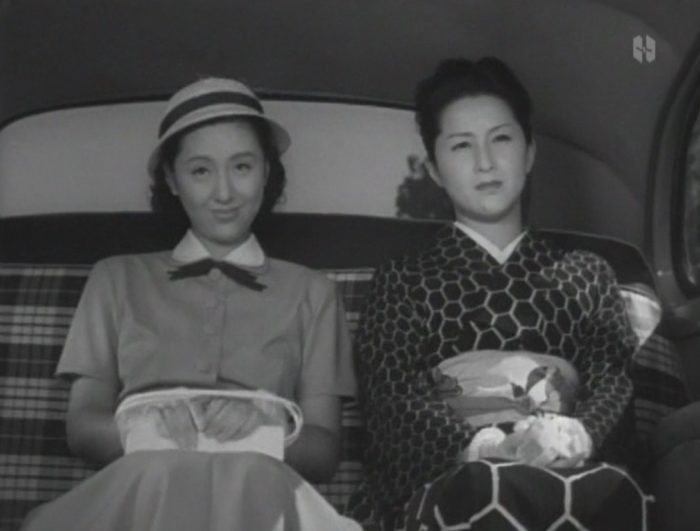Along with Akira Kurosawa, Yasujiro Ozu is the world’s most famous Japanese film director. However, their themes and styles are different, and their aesthetics are completely different. Ozu continued to make films of the genre called “domestic comedy” before and after the WW2. In particular, many of them are about marriage and family. Western directors and critics appreciate the distinctive style of visual expression. Attention is paid to every detail, from props to interior, and fashion is no exception.
I would like to think about that style through kimonos.This time,I look at the yukata appearance of women in “Ochazuke no Aji (Flavor of Green Tea Over Rice) ” (1952).
In short, the theme of the movie is “crumbling marriages”.It is a story about a marital couple getting tired and renewing their mood with a certain incident. The wife, who grew up in an upper-class family in Tokyo, does not like her husband, who is a manager of a large company with overseas branches, who is from the countryside and has no sophistication.
One day, with classmates of girl high school and a niece ,she goes on a overnight trip to a hot spring resort near Tokyo. After taking a bath, the four people wear yukatas provided by the inn, drink alcohol, smoke cigarettes, and enjoy chatting. The wife thinks of a carp swimming in the pond as her husband, names it “Mr. Insensitivity,” throws food, and plays.
Japanese hot spring inns are equipped with yukatas that four people wear, and cotton jackets over them. However, the pattern of the yukata they wear is unique. It is a big gourd like modern art. I guess the director made it specially for this scene. Ozu must have wanted to wear only the yukata he thought was beautiful.
It’s a black and white movie in 1950s, so I don’t know what color it is. However, I tried to guess the color using photo coloring software using AI technology. That is the next picture. The yukata may have been dyed in indigo blue, which is close to black, based on white.
They are women of the upper middle class, sophisticated in fashion, as you can see in the next scene. Only the main character wife is in kimono, and it can be seen that western clothes were already mainstream in the early 1950s. On the left is a niece heading to the city center by taxi to watch a French movie. She, unlike her aunts, refuses to arrange marriage. On the right, the wife and her classmates watch professional baseball games. There, a classmate who runs a clothes store accidentally finds her husband who comes to the baseball park with a woman. However, she does not mind.
One U.S. film critic sees the influence of the U.S. military occupying forces, women’s independence on such episodes and fashions, although the film does not explicitly show the elements of the U.S. military occupation. A yukata like modern art may be closer to symbolizing openness of sex than a traditional expression of feminine beauty.
The next scene is the yukata figure of the hero couple which made the original poster. At that time, men were almost 100% dressed outside in western clothes, but when they returned home and changed into yukata and relaxed. There is a maid in this house, and the wife does not cook.
Eventually, the couple reconcile by incidents associated with her husband’s transfer. In the next scene, the wife smiles while eating ochazuke(green tea over rice). Here, the yukata worn by his wife is the most common flower pattern in this movie. Although it is a large pattern, it is a pattern from before WW2.



When I looked for a picture of a yukata fashion in Ozu movies, I noticed that in the world-famous “Tokyo Story” (1953), Setsuko Hara was in a yukata with the same pattern. She is the son’s wife who died in the war that cares gently for the elderly couple who came to Tokyo from the countryside. Before sleeping in a room in a small apartment, she cares for her mother-in-law and strangles her shoulders

The movie was released one year after “Ochazuke no Aji”. Ozu may have reused the yukata. The yukata is a scene where each woman shows affection to her family as a wife and daughter-in-law. In that scene, the same traditional yukata with a floral pattern is used.
Of the kimonos, the style of wearing yukatas in bedrooms seems to have been replaced by Western-style pajamas in the 1960s. Nowadays, there is no scene of wearing yukatas indoors. On the other hand, the scenery of relaxing in a yukata at a hot spring inn has not changed at all. On the contrary, the yukata at the hot spring inn is extraordinary and enhances the sense of openness.
The next video is the trailer
The movie is in the public domain, so you can watch the full movie on YouTube.








